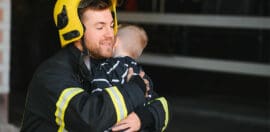What makes an organisation ‘child safe’?

17 June 2021 at 7:00 am
Child Wise shares findings from its recent category study on the awareness of what makes an organisation “child safe”.
Child Wise is a social enterprise part of Save the Children Australia that works with organisations across Australia and the Asia Pacific to help them build a strong child safe culture and environment for children and young people in their care.
In late 2020, Child Wise engaged the research and insights team at Southern Cross Austereo (SCA iQ) to conduct a comprehensive survey on 875 Australians who work or volunteer with or around children and people of young age. The main objective of the research was to gauge the level of understanding of public and private sector organisations about what constitutes a child safe organisation and importantly, what they think makes children feel safe in their organisation.
Please note: For the purpose of this article, the term “work” is used and may refer to work or volunteer, and the term “children” is used and may refer to children or young people.
Key insights
This article aims to summarise the extensive research undertaken by SCA iQ and Child Wise, by focusing on understanding the level of awareness of the surveyed sample for what makes an organisation child safe as well as any observed differences among industries.
Five key insights from the research are outlined below:
- One in four Australians have witnessed child safety issues in their current organisation.
- Overall, child safety could be said to be generally understood, however there remains a significant number of people who do not feel they could recognise child safety breaches, let alone report them.
- One in four Australians have witnessed child safety issues in their organisation, but over one in 10 doesn’t know or feel confident in reporting them.
- One in five Australians don’t know what their organisation’s child safety policies are.
- 15 per cent of respondents agree with the statement “I don’t really know what child safety means for my organisation”.
- One in four Australians who work with children have never participated in child safety training. This means there is a severe lack of awareness and knowledge around what makes a workplace child safe.
- 46 per cent of respondents “have not participated in child safety training in the past five years” and alarmingly 28 per cent “have never participated or organised child safety training”.
- Queenslanders and Western Australians are least likely to have ever been trained on child safety, with little difference between metro and regional.
- Too many children are unlikely to feel confident in speaking up about child safety issues. Organisations need to consider how they can better encourage, empower and support children in their workplace to feel they can easily express any concerns they have about child safety.
- Three in four (74 per cent) respondents thought that “feeling comfortable to raise concerns, issues, fears” would make young people feel safe at their workplace.
- Three in four (75 per cent) respondents agreed that “being listened to and believed” would make young people feel safe at their workplace.
One of the main insights gathered from the research highlights the fact that children are not valued enough – their basic inclusion, their ideas and their solutions are not as important as those of the adults they work with. They may not feel “part of the team”. Children are not being given the opportunity to be part of the child safety solution at their workplace – issues that are impacting them directly are being discussed without them and therefore cannot possibly truly reflect what is going on for them.
Minority groups of young children may also not be supported enough, especially those who identify as LGBTIQA+. However this may be reflective of a reduced number of minority groups actually in a workplace and/or knowledge to the wider workplace cohort about these young people. This in itself may talk to the lack of child safety training on policies if respondents are unaware of where their workplace stands.
It also became evident that in the Australian organisations where those surveyed work, too many child safety incidents are happening. Issues are arising clearly as a result of less than ideal child safety culture, practices and policies, and people are witnessing these happen. And it appears that too many people feel ill equipped to be aware of child safety breaches, let alone how to report them.
When it comes to the data related to child safety policies, the results still show some worrying facts. Child safety policies are in fact likely to be “set and forget”. With a largely reactive child safety culture present, it’s not surprising that reviewing policies is not a top priority. The research shows a general lack of understanding among those surveyed of what their workplace’s child safety policies might be.
As we start looking at differences among industries, the retail sector has the poorest child safety culture, attitudes and practices. The results of the survey show a worrying correlation in retail between a high level of direct and indirect weekly contact with children and a lack of ability/interest in recognising child safety concerns, and reporting them. If we think about the frequency with which children and young people move through department stores, toy stores, supermarkets, electronics stores, discount stores and pet stores, that’s quite frightening data. This is a sector that – more than any other sector surveyed – needs to understand that indirect contact still means a responsibility towards children.
On the other side of the spectrum, we found out that not-for-profit organisations understand what child safety means, with better culture and understanding than public and private sectors. NFP workers are the most trained in child safety (people working with children in a not for profit are a third more likely to have been trained in child safety in the past five years than those working in the private sector who work with children) and they are also the most equipped in recognising and reporting issues (perhaps due to a stronger child safety culture and training).
Conclusions
Overall it became clear that the more trained employees and volunteers are on child safety, the more they understand that child safety is beyond just having friendly adult staff at work. It’s more about in-depth, EQ factors such as being listened to, believed and having a voice – ultimately creating an appropriate workplace culture.
There is an opportunity here to really educate organisations about how they can create a child-first culture that brings children to the decision table, as “creating opportunities for children to contribute to decisions made about the organisation” scored the lowest for workplace performance.
Ultimately the research has shown a need for an organisational culture where children feel they can speak up, an open physical space, and strong child safety training and policies in place – for some sectors more prominently than others.
To find out more about how Child Wise can help your organisation become a safe environment for children and young people, please call 1300 244 539 or email info@childwise.org.au.








